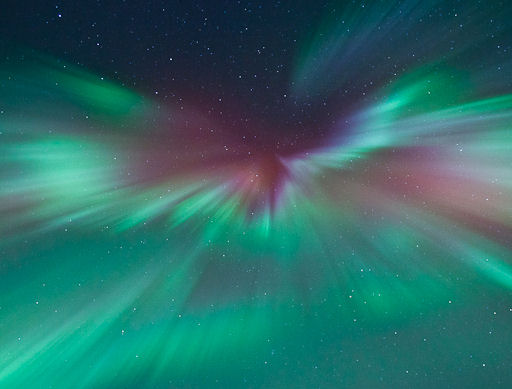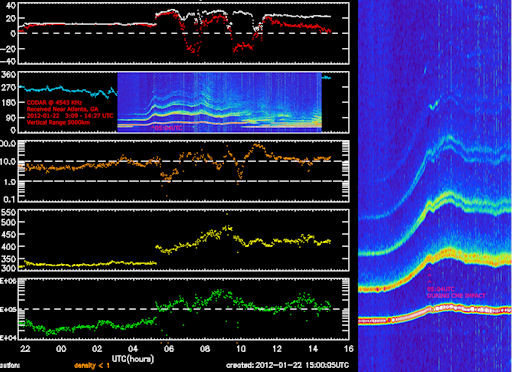HIGH-LATITUDE AURORAS: The Arctic Circle is alight with auroras following this morning's CME impact. Incoming reports from Russia and Norway confirm a bright apparition underway now. Aurora alerts: text, voice.
CME IMPACT: Arriving a little later than expected, a coronal mass ejection (CME) hit Earth's magnetic field at 0617 UT on Jan. 22nd. According to analysts at the Goddard Space Weather Lab, the impact strongly compressed Earth's magnetic field and briefly exposed satellites in geosynchronous orbit to solar wind plasma. Shifting lines of magnetic force induced strong ground currents in Norway and sparked bright auroras over the upper reaches of North America. This colorful corona appeared over Chatanika, Alaska:
"We enjoyed some amazing displays as the late arriving CME made its presence felt," says photographer Ronn Murray.
The impact also disturbed Earth's ionosphere. In Atlanta, Georgia, radio engineer Pieter Ibelings monitored a 4.5 MHz CODAR (coastal radar) signal as it bounced off layers of ionization along the US east coast. "The moment of impact can be clearly seen on the CODAR radar plot," he points out:
"The CODAR transmitters are located all around the coast and are used for mapping the ocean currents to a distance of about 200 miles," Pieter explains. "These signals also propagate through the ionosphere so they can be picked up all around the world. The signals are almost perfect for ionospheric sounding since they are linear chirps. I capture the chirp with a receiver locked to GPS both in frequency and time. I then de-chirp the waveform so I can extract the time of arrival information at my location."
The CODAR echoes show ionization layers shifting vertical position by some hundreds of kilometers, changes that surely affected the propagation of HF radio signals in the aftermath of the impact. More information about Pieter's observations may be found here.
more aurora images: from Lance Parrish of Skiland, Alaska; from Coby Brock of North Pole, Alaska; from Phil Hart of Lake Laberge, Yukon, Canada; from Jason Ahrns of Chatanika, Alaska; from John Dean of Nome, Alaska; from Sam Tsai of Grande Prairie, Alberta, Canada; from Chad Blakley of Aurora Sky Station, Abisko National Park, Sweden; from Andrei Penescu of Kangerlussuaq, Greenland; from Marketa Stanczykova of Chatanika, Alaska; from Kimberly S Mietzah Damkoehler of Houston, Alaska;

![]()
Solar wind
speed: 394.2 km/sec
density: 4.5 protons/cm3
explanation | more data
Updated: Today at 2126 UT
![]()
X-ray Solar Flares
6-hr max: C2 2053 UT Jan22
24-hr: C7 0257 UT Jan22
explanation | more data
Updated: Today at: 2100 UT
![]()
![]()
![]()
Daily Sun: 22 Jan 12
![]()
![]()
Sunspot 1401 poses a continued threat for M-class solar flares. Credit: SDO/HMI
![]()
![]()
![]()
Sunspot number: 102
What is the sunspot number?
Updated 21 Jan 2012
Spotless Days
Current Stretch: 0 days
2012 total: 0 days (0%)
2011 total: 2 days (<1%)
2010 total: 51 days (14%)
2009 total: 260 days (71%)
Since 2004: 821 days
Typical Solar Min: 486 days
Updated 21 Jan 2012
The Radio Sun
10.7 cm flux: 142 sfu
explanation | more data
Updated 21 Jan 2012
![]()
![]()
![]()
Current Auroral Oval:
![]()
Switch to: Europe, USA, New Zealand, Antarctica
Credit: NOAA/POES
![]()
![]()
![]()
Planetary K-index
Now: Kp= 5 storm
24-hr max: Kp= 5 storm
explanation | more data
![]()
Interplanetary Mag. Field
Btotal: 14.3 nT
Bz: 6.7 nT south
explanation | more data
Updated: Today at 2126 UT
![]()
![]()
![]()
Coronal Holes: 22 Jan 12
![]()
![]()
Solar wind flowing from the indicated coronal hole should reach Earth on Jan. 27-28. Credit: SDO/AIA.






